2014 PEUGEOT 3008 dashboard
[x] Cancel search: dashboardPage 60 of 389
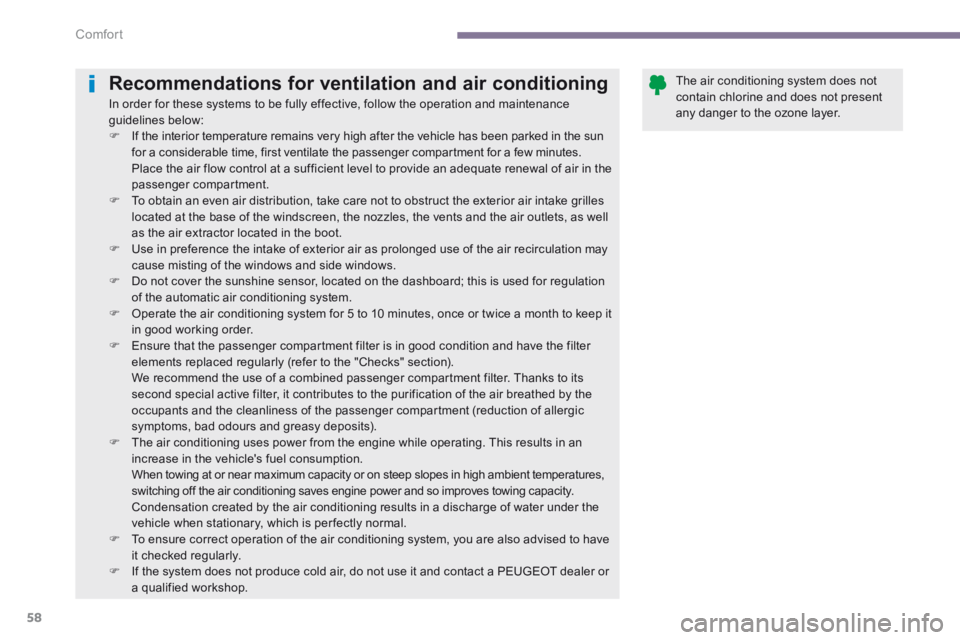
Comfort
58
Recommendations for ventilation and air conditioning
In order for these systems to be fully effective, follow the operation and maintenance guidelines below: If the interior temperature remains very high after the vehicle has been parked in the sun for a considerable time, first ventilate the passenger compartment for a few minutes. Place the air flow control at a sufficient level to provide an adequate renewal of air in the passenger compartment. To obtain an even air distribution, take care not to obstruct the exterior air intake grilles located at the base of the windscreen, the nozzles, the vents and the air outlets, as well as the air extractor located in the boot. Use in preference the intake of exterior air as prolonged use of the air recirculation may cause misting of the windows and side windows. Do not cover the sunshine sensor, located on the dashboard; this is used for regulation of the automatic air conditioning system. Operate the air conditioning system for 5 to 10 minutes, once or twice a month to keep it in good working order. Ensure that the passenger compartment filter is in good condition and have the filter elements replaced regularly (refer to the "Checks" section). We recommend the use of a combined passenger compartment filter. Thanks to its second special active filter, it contributes to the purification of the air breathed by the occupants and the cleanliness of the passenger compartment (reduction of allergic symptoms, bad odours and greasy deposits).
The air conditioning uses power from the engine while operating. This results in an increase in the vehicle's fuel consumption. When towing at or near maximum capacity or on steep slopes in high ambient temperatures, switching off the air conditioning saves engine power and so improves towing capacity. Condensation created by the air conditioning results in a discharge of water under the vehicle when stationary, which is per fectly normal. To ensure correct operation of the air conditioning system, you are also advised to have it checked regularly. If the system does not produce cold air, do not use it and contact a PEUGEOT dealer or
a qualified workshop.
The air conditioning system does not contain chlorine and does not present any danger to the ozone layer.
Page 80 of 389
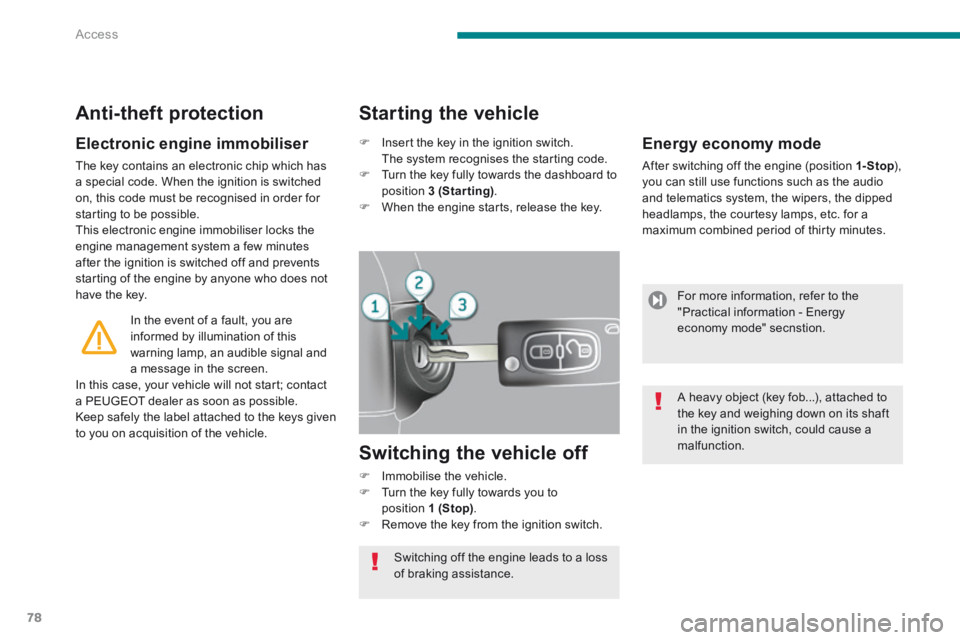
Access
78
Electronic engine immobiliser
The key contains an electronic chip which has a special code. When the ignition is switched on, this code must be recognised in order for starting to be possible. This electronic engine immobiliser locks the engine management system a few minutes after the ignition is switched off and prevents starting of the engine by anyone who does not have the key.
Anti-theft protection
In the event of a fault, you are informed by illumination of this warning lamp, an audible signal and a message in the screen. In this case, your vehicle will not start; contact a PEUGEOT dealer as soon as possible. Keep safely the label attached to the keys given to you on acquisition of the vehicle.
Starting the vehicle
Insert the key in the ignition switch. The system recognises the starting code. Turn the key fully towards the dashboard to position 3 (Starting) . When the engine starts, release the key.
Switching the vehicle off
Immobilise the vehicle. Turn the key fully towards you to position 1 (Stop) . Remove the key from the ignition switch.
Switching off the engine leads to a loss of braking assistance.
Energy economy mode
After switching off the engine (position 1- Stop ), 1- Stop ), 1- Stopyou can still use functions such as the audio and telematics system, the wipers, the dipped headlamps, the courtesy lamps, etc. for a maximum combined period of thirty minutes.
For more information, refer to the "Practical information - Energy economy mode" secnstion.
A heavy object (key fob...), attached to the key and weighing down on its shaft in the ignition switch, could cause a malfunction.
Page 152 of 389
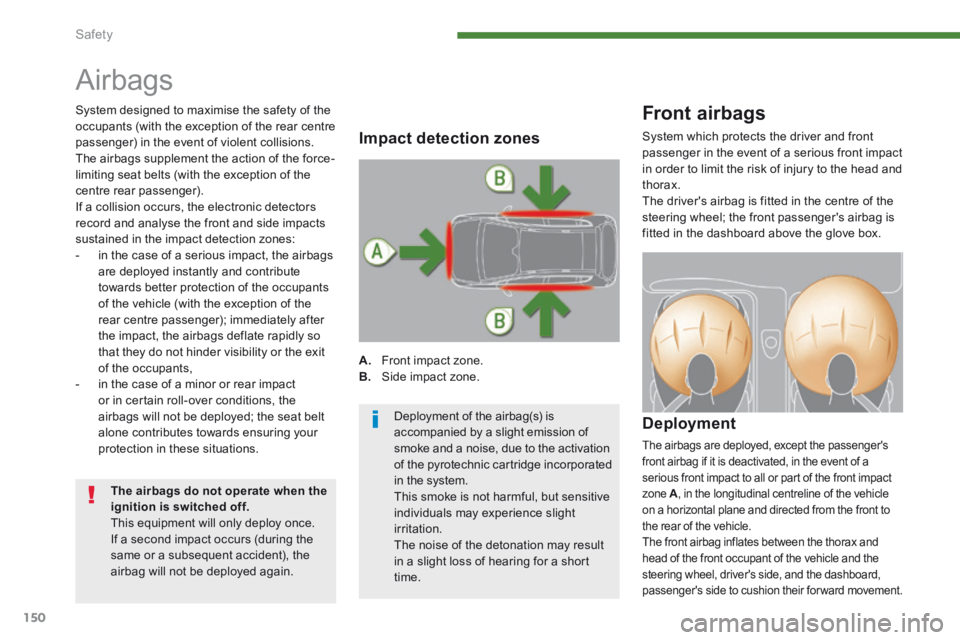
Safety
150
Airbags
Front airbags
Deployment
The airbags are deployed, except the passenger's front airbag if it is deactivated, in the event of a serious front impact to all or part of the front impact zone A , in the longitudinal centreline of the vehicle on a horizontal plane and directed from the front to the rear of the vehicle. The front airbag inflates between the thorax and head of the front occupant of the vehicle and the steering wheel, driver's side, and the dashboard, passenger's side to cushion their forward movement.
Impact detection zones
A. Front impact zone. B. Side impact zone.
System designed to maximise the safety of the occupants (with the exception of the rear centre passenger) in the event of violent collisions. The airbags supplement the action of the force-limiting seat belts (with the exception of the centre rear passenger). If a collision occurs, the electronic detectors record and analyse the front and side impacts sustained in the impact detection zones: - in the case of a serious impact, the airbags are deployed instantly and contribute towards better protection of the occupants of the vehicle (with the exception of the rear centre passenger); immediately after the impact, the airbags deflate rapidly so that they do not hinder visibility or the exit of the occupants, - in the case of a minor or rear impact or in certain roll-over conditions, the airbags will not be deployed; the seat belt alone contributes towards ensuring your protection in these situations.
System which protects the driver and front passenger in the event of a serious front impact in order to limit the risk of injury to the head and thorax. The driver's airbag is fitted in the centre of the steering wheel; the front passenger's airbag is
fitted in the dashboard above the glove box.
Deployment of the airbag(s) is
accompanied by a slight emission of smoke and a noise, due to the activation of the pyrotechnic cartridge incorporated in the system. This smoke is not harmful, but sensitive individuals may experience slight irritation. The noise of the detonation may result in a slight loss of hearing for a short time.
The airbags do not operate when the ignition is switched off. This equipment will only deploy once.
If a second impact occurs (during the same or a subsequent accident), the airbag will not be deployed again.
Page 155 of 389
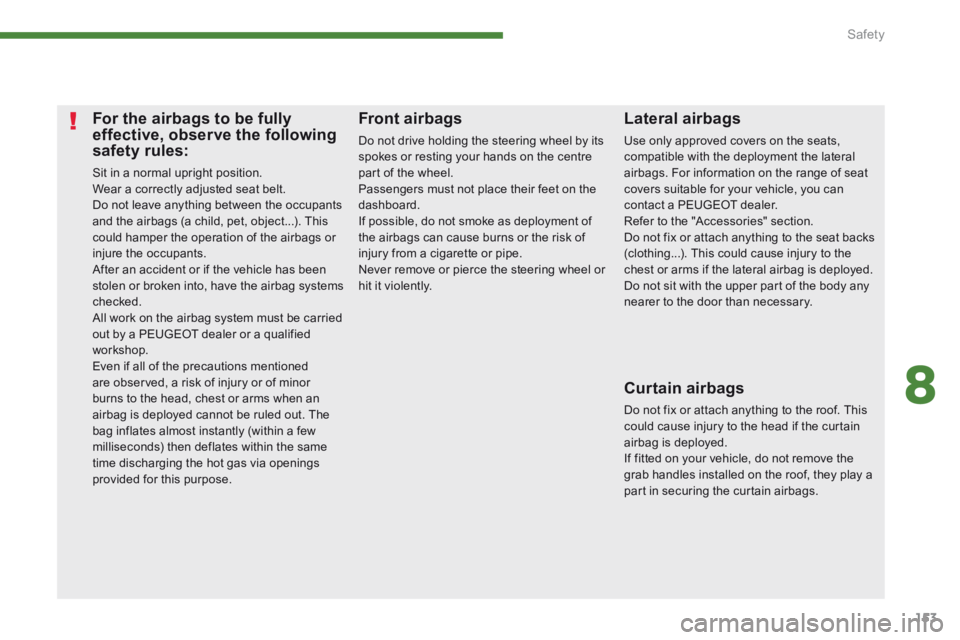
8
Safety153
For the airbags to be fully effective, observe the following safety rules:
Sit in a normal upright position. Wear a correctly adjusted seat belt. Do not leave anything between the occupants and the airbags (a child, pet, object...). This could hamper the operation of the airbags or injure the occupants. After an accident or if the vehicle has been stolen or broken into, have the airbag systems checked. All work on the airbag system must be carried out by a PEUGEOT dealer or a qualified workshop. Even if all of the precautions mentioned are observed, a risk of injury or of minor burns to the head, chest or arms when an airbag is deployed cannot be ruled out. The bag inflates almost instantly (within a few milliseconds) then deflates within the same time discharging the hot gas via openings provided for this purpose.
Lateral airbags
Use only approved covers on the seats, compatible with the deployment the lateral airbags. For information on the range of seat covers suitable for your vehicle, you can contact a PEUGEOT dealer. Refer to the "Accessories" section. Do not fix or attach anything to the seat backs (clothing...). This could cause injury to the chest or arms if the lateral airbag is deployed. Do not sit with the upper part of the body any nearer to the door than necessary.
Front airbags
Do not drive holding the steering wheel by its spokes or resting your hands on the centre part of the wheel. Passengers must not place their feet on the dashboard. If possible, do not smoke as deployment of the airbags can cause burns or the risk of injury from a cigarette or pipe. Never remove or pierce the steering wheel or hit it violently.
Curtain airbags
Do not fix or attach anything to the roof. This could cause injury to the head if the curtain airbag is deployed. If fitted on your vehicle, do not remove the grab handles installed on the roof, they play a part in securing the curtain airbags.
Page 224 of 389
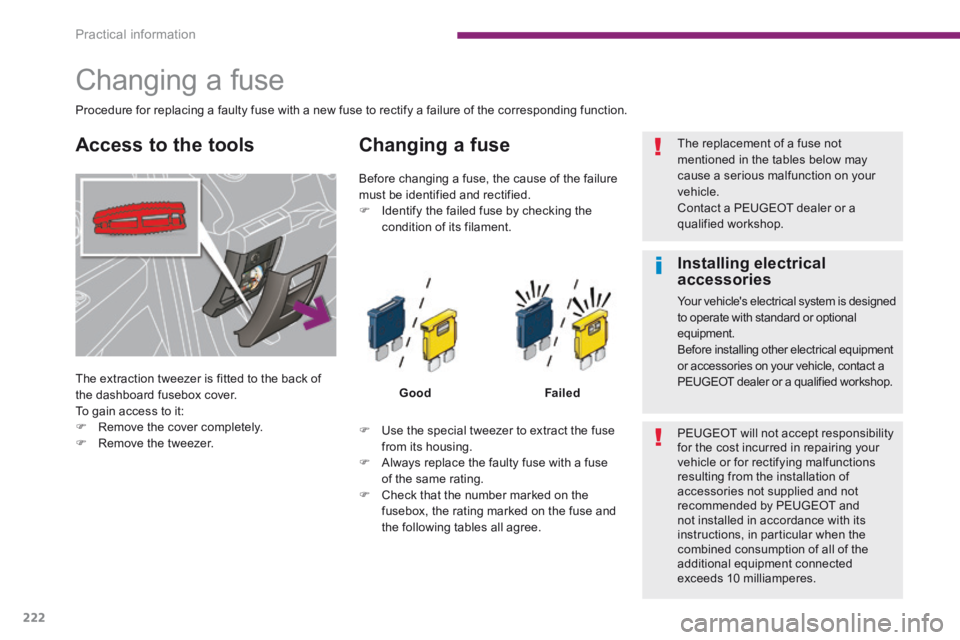
Practical information
222
Changing a fuse
The extraction tweezer is fitted to the back of
the dashboard fusebox cover. To gain access to it: Remove the cover completely.
Remove the tweezer.
Changing a fuse
GoodFailed
Use the special tweezer to extract the fuse from its housing. Always replace the faulty fuse with a fuse of the same rating. Check that the number marked on the fusebox, the rating marked on the fuse and the following tables all agree.
Before changing a fuse, the cause of the failure must be identified and rectified. Identify the failed fuse by checking the
condition of its filament.
Procedure for replacing a faulty fuse with a new fuse to rectify a failure of the corresponding function.
The replacement of a fuse not mentioned in the tables below may cause a serious malfunction on your vehicle. Contact a PEUGEOT dealer or a qualified workshop.
PEUGEOT will not accept responsibility for the cost incurred in repairing your vehicle or for rectifying malfunctions resulting from the installation of accessories not supplied and not recommended by PEUGEOT and not installed in accordance with its instructions, in particular when the combined consumption of all of the additional equipment connected exceeds 10 milliamperes.
Access to the tools
Installing electrical accessories
Your vehicle's electrical system is designed to operate with standard or optional equipment. Before installing other electrical equipment or accessories on your vehicle, contact a PEUGEOT dealer or a qualified workshop.
Page 225 of 389
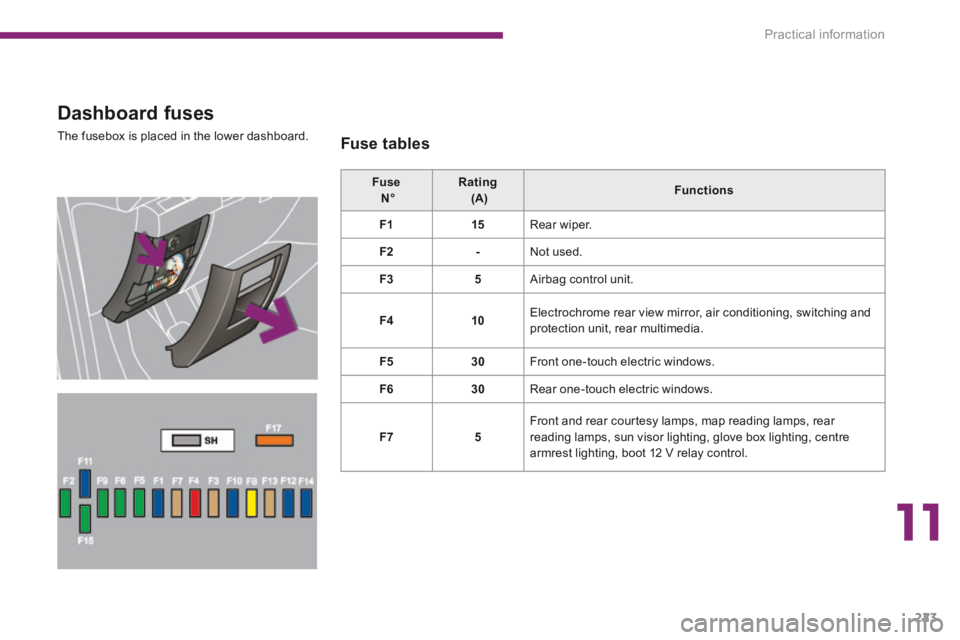
11
Practical information223
Dashboard fuses
The fusebox is placed in the lower dashboard. Fuse tables
Fuse N° Rating (A) Functions
F115 Rear wiper.
F2- Not used.
F35 Airbag control unit.
F410 Electrochrome rear view mirror, air conditioning, switching and protection unit, rear multimedia.
F530 Front one-touch electric windows.
F630 Rear one-touch electric windows.
F75 Front and rear courtesy lamps, map reading lamps, rear reading lamps, sun visor lighting, glove box lighting, centre armrest lighting, boot 12 V relay control.
Page 375 of 389
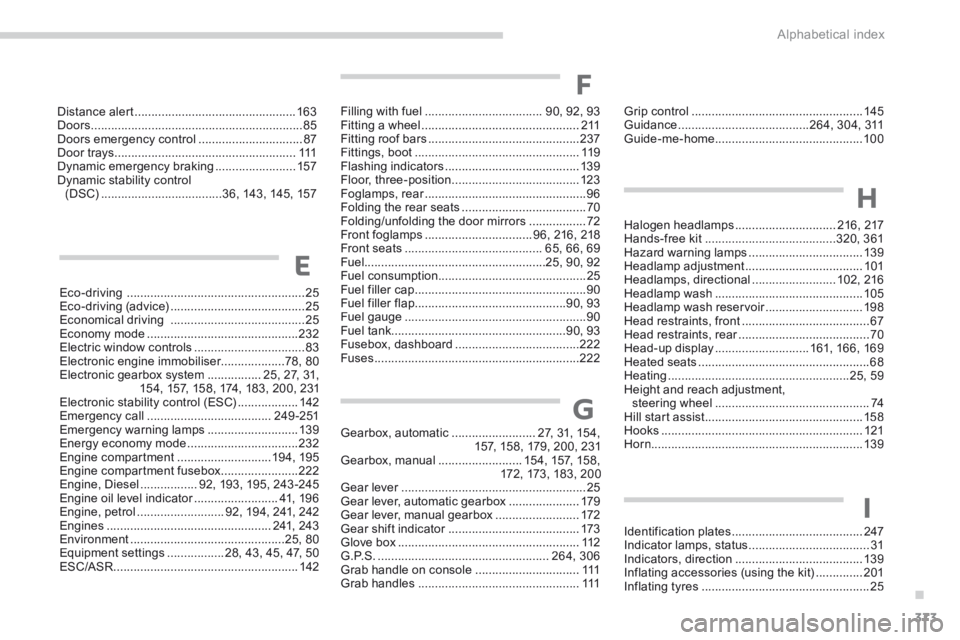
.
Alphabetical index373
Eco-driving .....................................................25Eco-driving (advice) ........................................25Economical driving ........................................25Economy mode .............................................232Electric window controls .................................83Electronic engine immobiliser...................78, 80Electronic gearbox system ................25, 27, 31,154, 157, 158, 174, 183, 200, 231Electronic stability control (ESC) ..................142Emergency call .....................................24 9 - 2 51Emergency warning lamps ...........................13 9Energy economy mode .................................232Engine compartment ............................19 4, 195Engine compartment fusebox .......................222Engine, Diesel .................92, 193, 195, 243 -245Engine oil level indicator .........................Engine oil level indicator .........................Engine oil level indicator41, 196Engine, petrol ..........................92, 194, 241, 242Engines .................................................241, 243Environment ..............................................25, 80Equipment settings .................28, 43, 45, 47, 50ESC/ASR .......................................................142
Gearbox, automatic .........................27, 31, 154,157, 158, 179, 200, 231Gearbox, manual .........................15 4, 157, 15 8,172, 173, 183, 200Gear lever .......................................................Gear lever .......................................................Gear lever25Gear lever, automatic gearbox .....................179Gear lever, manual gearbox .........................172Gear shift indicator .......................................Gear shift indicator .......................................Gear shift indicator173Glove box ......................................................112G . P. S . ...................................................264, 306Grab handle on console ...............................111Grab handles ................................................111
Identification plates .......................................247Indicator lamps, status ....................................31Indicators, direction ......................................13 9Inflating accessories (using the kit) ..............201Inflating tyres ..................................................25
E
G
I
F
Distance alert ................................................163Doors ...............................................................85Doors emergency control ...............................87Door trays ......................................................111Dynamic emergency braking ........................157Dynamic stability control (DSC) ....................................36, 143, 145, 157
Filling with fuel ...................................90, 92, 93Fitting a wheel ...............................................2 11Fitting roof bars .............................................237Fittings, boot .................................................11 9Flashing indicators ........................................13 9Floor, three-position ......................................123Foglamps, rear ................................................Foglamps, rear ................................................Foglamps, rear96Folding the rear seats .....................................70Folding/unfolding the door mirrors .................72Front foglamps ................................96, 216, 218Front seats .........................................65, 66, 69Fuel......................................................25, 90, 92Fuel consumption ............................................25Fuel filler cap ...................................................90Fuel filler flap .............................................90, 93Fuel gauge ......................................................90Fuel tank....................................................90, 93Fusebox, dashboard .....................................222Fuses .............................................................222
Grip control ...................................................145Guidance .......................................264, 304, 311Guide-me-home ............................................10 0
H
Halogen headlamps ..............................216, 217Hands-free kit .......................................320, 361Hazard warning lamps ..................................13 9Headlamp adjustment ...................................101Headlamps, directional .........................102, 216Headlamp wash ............................................105Headlamp wash reservoir .............................Headlamp wash reservoir .............................Headlamp wash reservoir198Head restraints, front ......................................67Head restraints, rear .......................................Head restraints, rear .......................................Head restraints, rear70Head-up display ............................161, 166, 169Heated seats ...................................................68Heating ......................................................25, 59Height and reach adjustment, steering wheel ..............................................74Hill start assist ...............................................15 8Hooks ............................................................121Horn...............................................................13 9
Page 381 of 389
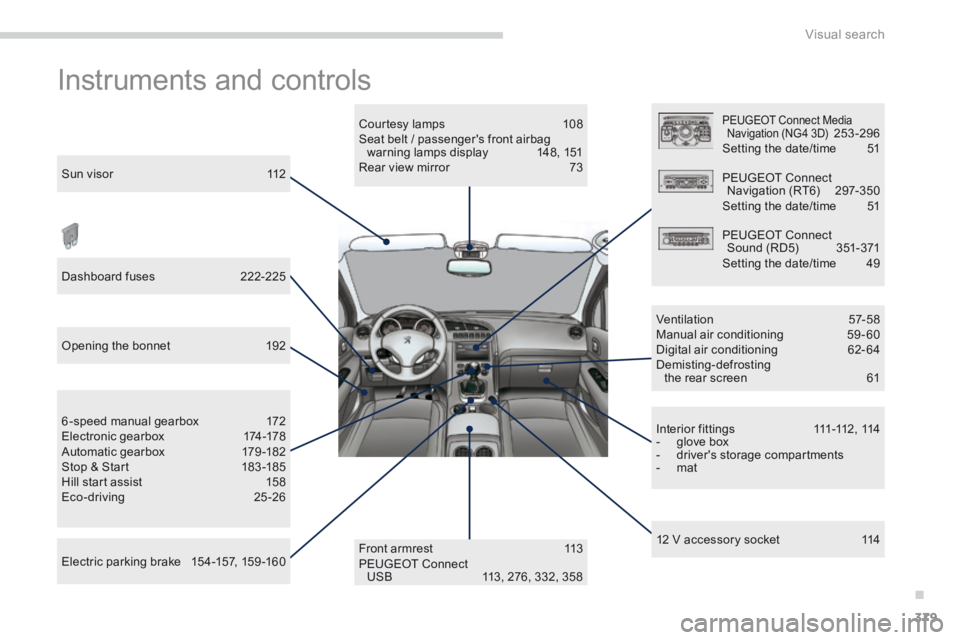
.
Visual search379
Instruments and controls
Sun visor 112
Dashboard fuses 222-225
Opening the bonnet 192
Electric parking brake 154-157, 159 -160
6-speed manual gearbox 172 Electronic gearbox 174-178 Automatic gearbox 179 -182 Stop & Start 183 -185 Hill start assist 158 Eco-driving 25 -26
Front armrest 113 PEUGEOT Connect USB 113, 276, 332, 358
Courtesy lamps 108 Seat belt / passenger's front airbag warning lamps display 148, 151 Rear view mirror 73
PEUGEOT Connect Media Navigation (NG4 3D) 253 -296 Setting the date/time 51
PEUGEOT Connect Navigation (RT6) 297-350 Setting the date/time 51
PEUGEOT Connect Sound (RD5) 351-371 Setting the date/time 49
Ventilation 57-58 Manual air conditioning 59 - 60 Digital air conditioning 62-64 Demisting-defrosting the rear screen 61
I n t e r i o r f i t t i n g s 111 -112 , 114 - glove box - driver's storage compartments - mat
12 V accessory socket 114